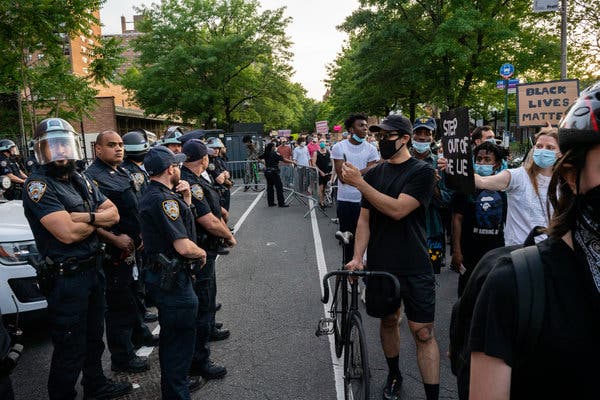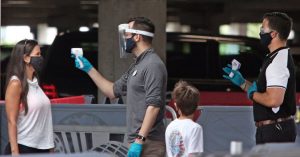Weather: Mostly sunny, with a high in the mid-80s.
Alternate-side parking: Suspended through June 21.
A video shows a police officer violently shoving a young woman to the ground and cursing at her during a protest in Brooklyn. A second recording shows the officer thrusting his arm into her torso.
The woman says that as a result, she suffered a concussion and seizures.
The incident, one of many captured on cellphones and shared across social media during the demonstrations in New York and other cities against police brutality, has led to calls for a change to the status quo — including some from New York State legislative leaders, who have begun approving parts of an expansive package of bills targeting police misconduct.
On Tuesday — 11 days after that Brooklyn protest — the district attorney’s office in the borough charged the officer, Vincent D’Andraia, with assault.
Officer D’Andraia is the first member of the New York Police Department to face criminal charges over conduct at the protests. Police union leaders said city officials were bowing to public pressure and abandoning officers.
[Read more: An officer who shoved a protester in Brooklyn is charged with assault.]
The details
The first video showed Officer D’Andraia, 28, knocking the woman, Dounya Zayer, 20, to the ground and calling her a “bitch” after she asked him why he had told her to get out of the street. The second video, recorded by a Newsweek reporter, shows Officer D’Andraia leaning forward and thrusting his arm into Ms. Zayer’s body.
Officer D’Andraia was arrested and charged with misdemeanor assault, criminal mischief, harassment and menacing. Ms. Zayer’s lawyer, Tahani Aboushi, said that she was disappointed that prosecutors had not charged him with a felony.
The officer’s lawyer, Stuart London, declined to comment. Patrick J. Lynch, the president of the Police Benevolent Association, said the mayor and top police officials had sent officers to the protests “with no support and no clear plan.”
The context
Law enforcement officials said prosecutors were weighing criminal charges against as many as 40 New York City police officers for their conduct at the protests. The local demonstrations began May 28, following the May 25 death of George Floyd, a black man, at the hands of the Minneapolis police.
A civilian agency that investigates police misconduct in New York said it had received hundreds of complaints since the protests began.
Officer D’Andraia and another officer in Brooklyn were suspended without pay from the Police Department last week. The second officer, who has not been publicly identified, is seen on a video pulling down the mask of a young man and pepper-spraying him. That officer was also expected to face criminal charges, according to four law enforcement sources.
The precedent
People have long criticized the handling of police brutality complaints, and in 2014, the last words of Eric Garner — “I can’t breathe,” as he was held in a chokehold by an officer on Staten Island — helped galvanize the Black Lives Matter movement. Mr. Floyd said the same words as an officer’s knee was pressed on his neck.
A witness recorded the Garner incident on his cellphone. Five years later, the officer, Daniel Pantaleo, was fired from the department. Mayor Bill de Blasio blamed the delay on the Department of Justice, which after a long investigation declined to bring criminal charges.
The reaction
Mr. de Blasio has agreed to shift an unspecified amount of money from the Police Department to youth and community development programs. Even current and former members of the mayor’s administration said the announced changes were not enough. New York State legislators began to approve a broad package of bills targeting police misconduct, including a ban on chokeholds.
In another incident related to the demonstrations after Mr. Floyd’s death, 57 officers resigned from the Buffalo Police Department’s Emergency Response Team in protest after two of their fellow officers were charged with felony assault this week. A video showed the two officers knocking a 75-year-old man, Martin Gugino, to the ground and walking past him as he lay bleeding. President Trump falsely claimed on Tuesday that Mr. Gugino was an “Antifa provocateur.”
From The Times
Inside the Newly Spotless Subway: ‘I’ve Never Seen It Like This’
Solving the Mystery of What Became of J.F.K.’s Other Patrol Boat
Child Abuse Cases Drop 51 Percent. The Authorities Are Very Worried.
Environmentalists Targeted Exxon Mobil. Then Hackers Targeted Them.
From New York Times Opinion: The Bronx and Queens Are Crying Out for Help
Want more news? Check out our full coverage.
The Mini Crossword: Here is today’s puzzle.
What we’re reading
Some restaurants and bars in Lower Manhattan are not waiting until Phase 2 of the reopening to set up outdoor tables and chairs for customers. [Eater New York]
One street in each borough will be renamed in support of the Black Lives Matter movement. [SILive.com]
A real estate agent in Florida used an image of a New York City police van on fire in an email to attract prospective buyers. The agent was later fired from his firm, which is based in New York. [The Real Deal]
And finally: Magician who cast a spell of warmth
The Times’s John Leland reports:
When Bradley Feldstein was 13 or 14 and practicing simple magic tricks at school in Queens, his mother ran an answering service. One of her customers was Jack Adams, a magician. “You must meet my son,” Rosalind Feldstein told her client, and soon Bradley became the magician’s assistant, working for $5 a show. His future was set.
Bradley Fields, as he called himself, spent the next 55 years honing a career as an illusionist, actor and educator, often using magic to teach math to children.
In April, at home in Washington, he developed a sore throat. “I hope it’s just a cold,” he texted his longtime girlfriend, Stephanie Chaikin, in New York. He died of Covid-19 at MedStar Washington Hospital Center on May 5, Ms. Chaikin said. He was 68.
Mr. Fields was born in Spring Valley, N.Y., on July 24, 1951. He got his start in the folk clubs of Greenwich Village, opening for musicians. He graduated to headlining around the country and abroad.
Like Mr. Adams, he emphasized stories and an emotional connection with the audience over flashy spectacle. “He was never a fan of that type of magic,” his son Noah said.
After Noah and his brother, Jonathan, were born, Mr. Fields spent a year teaching elementary school in Manhattan’s Chinatown, which inspired him to create MatheMagic, a show for children that he performed up to 200 times a year.
“He chose to do these children’s shows rather than go to Vegas, where he could have made more money,” said William Stixrud, a friend.
It’s Wednesday — share your magic.
Metropolitan Diary: Coat check
Dear Diary:
In the early 1980s, before it expanded to its present size, the Frick Collection was a much more intimate museum with a small coat-check room just off the entrance.
On the rainy autumn afternoon when I visited, an older woman was taking coats and bags. We chatted while she took my umbrella.
When I gave her my raincoat, I asked her to please handle it with care, as it was about to lose a button.
Later, as I boarded the Madison Avenue bus, I began to button my raincoat. As I did, I realized that the woman at the coat check had sewn the loose button back on.
— Jessica Weber
New York Today is published weekdays around 6 a.m. Sign up here to get it by email. You can also find it at nytoday.com.
We’re experimenting with the format of New York Today. What would you like to see more (or less) of? Post a comment or email us: [email protected].



















